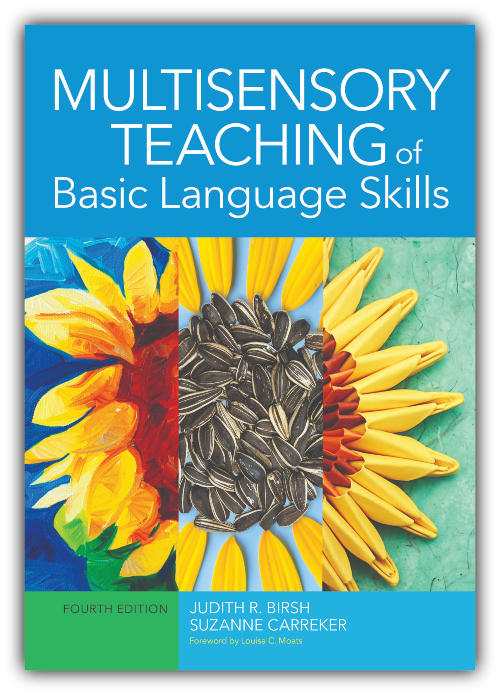9 Tips on Spelling Instruction for Students with Dyslexia
July 3, 2025
 Today’s post was adapted from “Teaching Spelling” by Suzanne Carreker, a chapter in Multisensory Teaching of Basic Language Skills, Fourth Edition, edited by Judith R. Birsh, Ed.D., CALT-QI, & Suzanne Carreker, Ph.D., CALT-QI
Today’s post was adapted from “Teaching Spelling” by Suzanne Carreker, a chapter in Multisensory Teaching of Basic Language Skills, Fourth Edition, edited by Judith R. Birsh, Ed.D., CALT-QI, & Suzanne Carreker, Ph.D., CALT-QI
Teaching students with dyslexia to spell requires careful lesson planning. Plan ahead for student success, and you’ll help learners build confidence and independence in this important area of literacy. Here are nine tips on effective instruction that strengthens the spelling skills of students with dyslexia.
Tip 1: Students with dyslexia need spelling instruction that is closely integrated with reading instruction. Because of the exacting demands of spelling on students’ complete and accurate recall of letter patterns, students with dyslexia need to spell words with sounds and patterns that have previously been introduced for reading and practiced. Reading words before spelling them heightens students’ awareness of orthographic patterns.
Tip 2: The number and choices of activities for a spelling lesson will depend on the readiness and needs of the student or students. You’ll want to plan a rotation of activities that ensures that all areas of spelling are covered regularly.
Tip 3: Discuss the meanings and usages of spelling words with students. This will help ensure that all the different layers of language structure are covered in a lesson.
Tip 4: Your spelling instruction will most likely need to address phonological processing because it is the primary deficit of students with dyslexia. Without phonemic awareness, students with dyslexia will not be able to develop facility in reading or spelling. Students should engage in activities that require segmenting words into sounds. As students prepare to spell words, have them engage in activities that heighten the recognition or discrimination of specific sounds, such as listening for a specific sound in a word or listening for the position of a specific sound in a word.
Tip 5: After letter–sound correspondences have been introduced for reading, they can be introduced for spelling. Review these spelling associations daily using a sound or spelling deck. Have students spell words and derivatives with regular spellings using these sounds, and introduce new spelling patterns or rules as needed.
Tip 6: Consider modifying your weekly spelling list for students with dyslexia. Rather than require these students to learn all of the words in the list, you might ask them to be responsible for only the discovery words from the Monday lesson (e.g., all of the words with medial /ou/ spelled ou).
Tip 7: To help students learn to spell irregular words, use this five-step multisensory procedure:
- Circle the irregular part. Give students a large model of the irregular word on a sheet of paper and have them circle the part of the word that does not conform to the reliable patterns or rules. Over time, students may begin to recognize patterns in irregular words.
- Trace a model. Students trace the model word three times, saying the word before they write and naming the letters as they write.
- Make copies. Students make three copies of the word with the model in view, saying the word and naming the letters as they write.
- Spell the word with eyes closed. Students close their eyes and spell the word, imagining the word as they spell. They open their eyes and check the model, and then close their eyes and spell the word two more times.
- Write from memory. Students turn their papers over. They write the word three times, saying the word before they write and naming the letters as they write.
Tip 8: Use analyzing and sorting activities to focus students’ attention on letter patterns in words, reinforce letter–sound correspondences, and help students generalize patterns and rules. Students can write words on individual index cards and analyze and sort them by sounds or letter patterns.
Tip 9: Have students compile a spelling notebook in which they record information about spelling. The notebooks could contain a section for spelling patterns, with one page for each speech sound. Students can write words that follow each pattern as well as exceptions to the patterns on each page as the sound and spelling(s) are taught. Students may also have a section for words that follow the usual spelling rules, with one page for each rule, and another section for irregular words, with one page for each letter of the alphabet. Students can record information in their spelling notebooks during each spelling lesson and review their notebooks anytime to reinforce spelling information.
Spelling is often a source of difficulty and frustration for learners with dyslexia. Use these tips as a starting point for spelling instruction that helps students overcome their challenges in this area and become skilled and confident spellers.




Write a Comment
Your email address will not be published. Required fields are marked *
Post a Comment